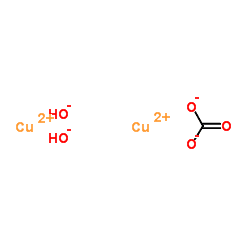Appearance gray powder | ||
 | ||
Copper(II) carbonate or cupric carbonate is a chemical compound with formula CuCO
3. At ambient temperatures, is an ionic solid (a salt) consisting of copper(II) cations Cu2+
and carbonate anions CO2−
3.
Contents
This compound is rarely encountered because it is difficult to prepare and readily reacts with water moisture from the air. The terms "copper carbonate", "copper(II) carbonate", and "cupric carbonate" almost always refer (even in chemistry texts) to a basic copper carbonate (or copper(II) carbonate hydroxide), such as Cu
2(OH)2CO
3 (which occurs naturally as the mineral malachite) or Cu
3(OH)2(CO
3)2 (azurite). For this reason, the qualifier neutral may be used instead of "basic" to refer specifically CuCO
3.
Preparation
Reactions that may be expected to yield CuCO
3, such as mixing solutions of copper(II) sulfate CuSO
4 and sodium carbonate Na
2CO
3 in ambient conditions, yield instead a basic carbonate and CO
2, due to the great affinity of the Cu2+
ion for the hydroxide anion HO−
.
Thermal decomposition of the basic carbonate at atmospheric pressure yields copper(II) oxide CuO rather than the carbonate.
In 1960, C. W. F. T. Pistorius claimed synthesis by heating basic copper carbonate at 180 °C in an atmosphere of carbon dioxide CO
2 (450 atm) and water (50 atm) for 36 hours. The bulk of the products was well-crystallized malachite Cu
2CO
3(OH)2, but a small yield of a rhombohedral substance was also obtained, claimed to be CuCO
3. However, this synthesis apparently was not reproduced.
Reliable synthesis of true copper(II) carbonate was reported for the first time in 1973 by Hartmut Ehrhardt and others. The compound was obtained as a gray powder, by heating basic copper carbonate in an atmosphere of carbon dioxide (produced by the decomposition of silver oxalate Ag
2C
2O
4) at 500 °C and 2 GPa (20,000 atm). The compound was determined to have the monoclinic structure.
Chemical and physical properties
The stability of dry CuCO
3 depends critically on the partial pressure of carbon dioxide (pCO2). It is stable for months in dry air, but should actually decompose slowly into CuO and CO
2 if pCO2 is less than 0.11 atm.
In the presence of water or moist air at 25 °C, CuCO3 is stable only for pCO2 above 4.57 atmospheres and pH between about 4 and 8. Below that pressure, it reacts with water to form a basic carbonate (azurite, Cu
3(CO
3)2(OH)2). In highly basic solutions, the complex anion Cu(CO
3)22− is formed instead.
The solubility product of the true copper(II) carbonate was measured by Reiterer and others as pKso = 11.45 ± 0.10 at 25 °C.
